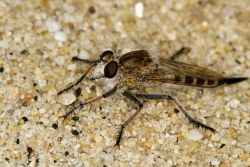Sand Fly

Description:
The appearance of sand flies and their painful bites that can cause secondary infection are the most frequently observed sign of an infestation. Also, evidence of sand fly problems includes the incidence of human and animal diseases that are transmitted by sand fly bites.
Appearance:
Sand fly adults are small flies – only about 3 mm long – and are golden, brownish or gray colored. They have long, piercing mouthparts that are well adapted for sucking blood from their selected host. Sand flies hold their hairy-looking wings in a vertical V-shape when at rest, a characteristic that distinguishes them from some other small flies. Also, the six legs on the adults are extremely long, being longer than the insect’s body.
Lifecycle:
Females prefer to lay their eggs in damp soil or in the water. Sand fly females must consume a blood meal to develop eggs. The larvae can take up to two years to develop and live in loose sand. In the pupal stage the larvae curls into a circle or “u” shape lasting one or two weeks.
Habits:
Female sand flies are blood feeders, but the males do not feed on blood. Both males and females also consume sugar-related nutrients that come from plant nectar or honeydew. Sand fly hosts vary a great deal. Some species feed on both mammals and reptiles in general sand fly bites are very painful. Most flies that bite humans feed during the evening and throughout the night. In some cases, flies will attack in the daytime, if they are disturbed while resting. Daytime resting sites include cavities close to the ground such as dry tree holes, hollow logs, palm tree crowns and the canopy of tropical and sub-tropical rain forest jungles. Another commonly found place for daytime resting is inside the home.